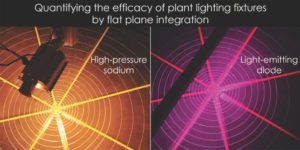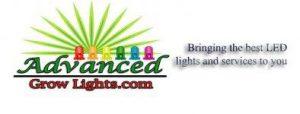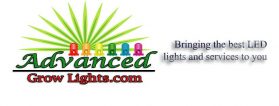By Erik Runkle and Bruce Bugbee
Plant lighting continues to be a hot topic, especially as light-emitting diode (LED) technology continues to advance. Growers commonly ask which type of lighting technology to purchase. Supplemental lighting using LEDs is usually more efficient, but the initial cost is higher than with high-pressure sodium (HPS) technology.
The choice of lamp types involves multiple factors:
- Hours per year of lamp operation
- Cost of electricity
- Cost to purchase, install and maintain the lamps
- Possible cost of additional electrical capacity for some lamp options
- Rebates available for upgrading to more efficient lighting
- Electrical efficiency (efficacy) of each lamp type
The choice of lighting technology should primarily (but not exclusively) be based on economics. How long will it take for the energy savings to pay for the new lighting system? The answer varies among facilities.
An informed decision relies on understanding plant lighting efficacy (efficiency). Efficiency and efficacy can be used interchangeably for most purposes but, technically speaking, efficiency is used only when the units in the numerator and denominator are the same, and it is thus possible to have 100 percent efficiency.
When the output (numerator) has a different unit than the input (denominator) the ratio is called efficacy. It does not make sense to talk about the efficiency of spraying a plant growth regulator, but we can measure the reduction in plant height and divide by the amount of chemical required to determine the efficacy of the treatment. The values for lighting have different input and output units, so the appropriate term is lighting efficacy.

Until recently, the efficacy of all electrical lighting products was based on human perception of light, which is strongly weighted toward green light. Human lighting is measured as luminous efficacy and has units of lumens per watt (the number of lumens produced per watt of energy consumed). In contrast, photons with wavelengths between 400 and 700 nm (referred to as photosynthetically active radiation, or PAR) drive photosynthesis, so the luminous efficacy metric is not appropriate for plant applications.
The appropriate metric for plant lighting is photosynthetic photon efficacy (PPE). This is the PAR photon output (unit of micromoles per second, or μmol·s–¹) divided by the input power (watts, or W) to produce that light. Thus, the unit becomes μmol·s–¹·W–¹, and because one watt (W) equals one joule per second (J·s–¹), the ratio can be simplified to μmol·J–¹ (μmol per second/joule per second).
The total output of a lamp can be measured by either flat plane integration (Figure 1) or by an integrating sphere, which is a hollow sphere that is covered with a white, highly reflective coating inside to reflect light. A lamp is inserted, and light output and the electrical input (including any ballast) are measured. An integrating sphere is expensive to purchase and requires expertise to operate and thus, these measurements are regularly done by inde…
Click link below for complete article
PDF: Plant Lighting Efficiency and Efficacy: μmols per joule

